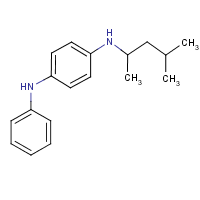1,4-Benzenediamine, N-(1,3-dimethylbutyl)-N'-phenyl-
Agent Name
1,4-Benzenediamine, N-(1,3-dimethylbutyl)-N'-phenyl-
CAS Number
793-24-8
Formula
C18-H24-N2
Major Category
Nitrogen Compounds

Synonyms
6PPD; Antage 6C; Antioxidant 4020; Antioxidant CD 13; Antozite 67; Antozite 67F; CD 13; DBDA; DMBPD; Diafen 13; Diafen FDMB; Dusantox 6PPD; Flexzone 7F; Flexzone 7L; Forte 6C; N-(1,3-Dimethylbutyl)-N'-phenyl-1,4-phenylenediamine; N-(1,3-Dimethylbutyl)-N'-phenyl-p-phenylenediamine; N-1,3-Dimethylbutyl-N'-phenyl-p-phenylendiamine; N-Phenyl-N'-(1,3-dimethyl butyl)-para-phenylenediamine; N-Phenyl-N'-(1,3-dimethylbutyl)-p-phenylenediamine; Nocrac 6C; Nocrane 6C; Nocrane 7 L; Ozonon 6C; Permanax 120; Permanax 6PPD; Santoflex 13; Santoflex 13F; Santoflex 6PPD; UOP 562; UOP 588; Vulkanox 4020; Wingstay 300; p-Phenylenediamine, N-(1,3-dimethylbutyl)-N'-phenyl-; [ChemIDplus] UN3077
Category
Amines, Polyaromatic
Description
Dark violet solid; [HSDB] Brown to violet solid; Turns dark brown on light exposure; [ICSC]
Sources/Uses
Used as an antiozonant and antioxidant for butadiene rubber, nitrile-butadiene rubber, styrene-butadiene rubber, and synthetic isoprene rubber; [HSDB]
Comments
Reports of skin sensitization in employees in tire and rubber industries; Not mutagenic in four strains of Salmonella and not clastogenic in mice bone marrow cells; Emergency treatment: "Paraphenylenediamine"; In sensitized individuals, paraphenylenediamine may cause allergic contact dermatitis following application as a hair dye and asthma following inhalation; Following ingestion, can cause angioneurotic edema, methemoglobinemia, acute tubular necrosis, and hepatotoxicity; An adult died after ingestion of 3 grams of p-phenylenediamine; Another adult who ingested 1800 mg developed angioneurotic edema and acute renal failure; [HSDB] A mild skin and eye irritant; May cause skin sensitization; [ICSC] May cause skin irritation and sensitization; [CAMEO] A mild skin and eye irritant; Likely a skin sensitizer based on animal studies and positive patch test results in volunteers exposed to rubber formulations; [CHEMINFO] See "p-Phenylenediamine."
Biomedical References
Exposure Assessment
MAK
2 mg/m3, inhalable fraction
Vapor Pressure
5E-06 mm Hg
Explanatory Notes
Flash point = 204 deg C; [CAMEO] The Guide in the Emergency Response Guidebook is for "Environmentally hazardous substances, solid, n.o.s."
Adverse Effects
Skin Sensitizer
Yes
Methemoglobinemia
MetHgb is secondary toxic effect
Hepatotoxin
Hepatoxic (a) from occupational exposure (secondary effect) or (b) in animal studies or in humans after ingestion
Diseases, Processes, and Activities Linked to This Agent
Diseases
Occupational diseases associated with exposure to this agent: